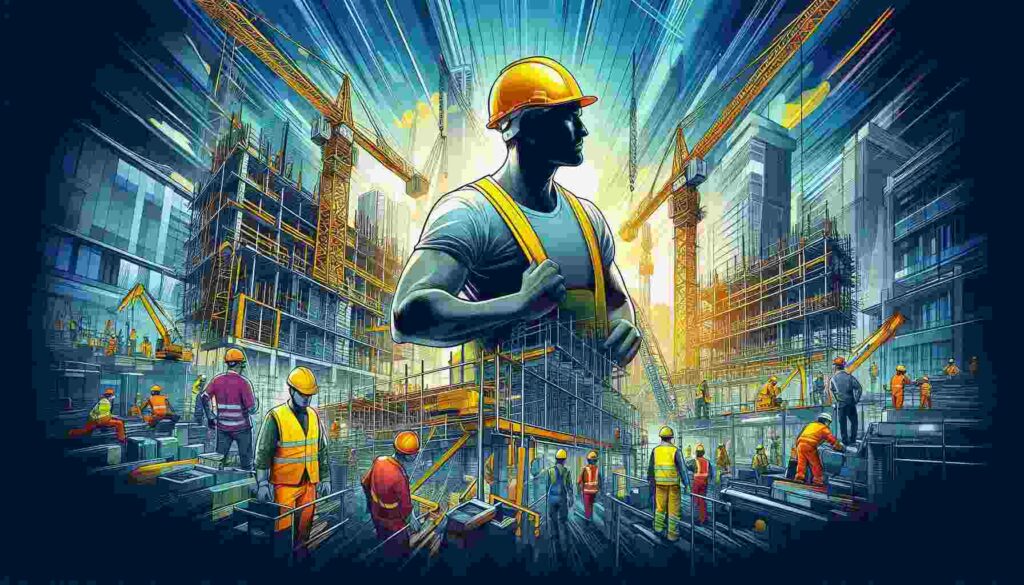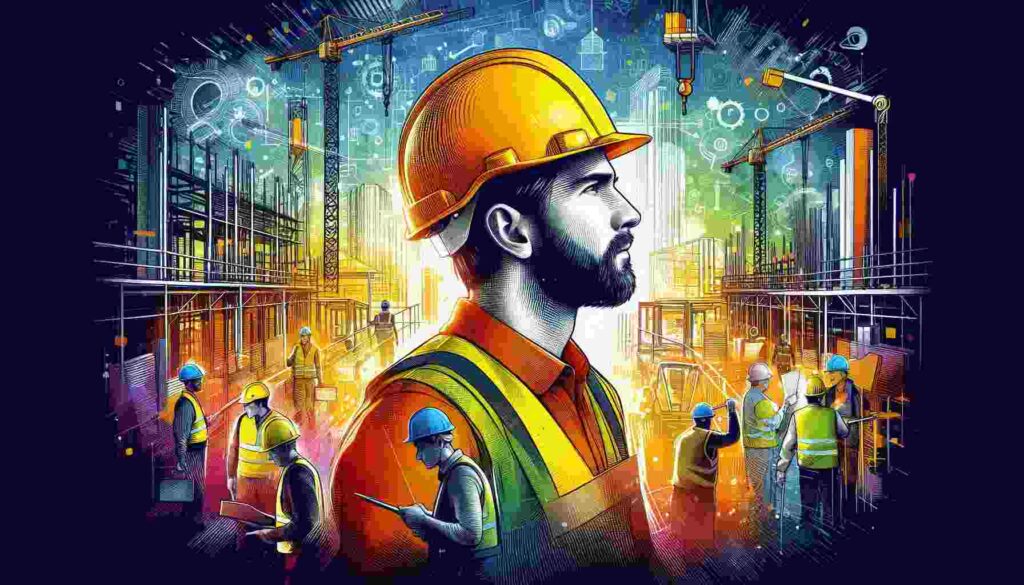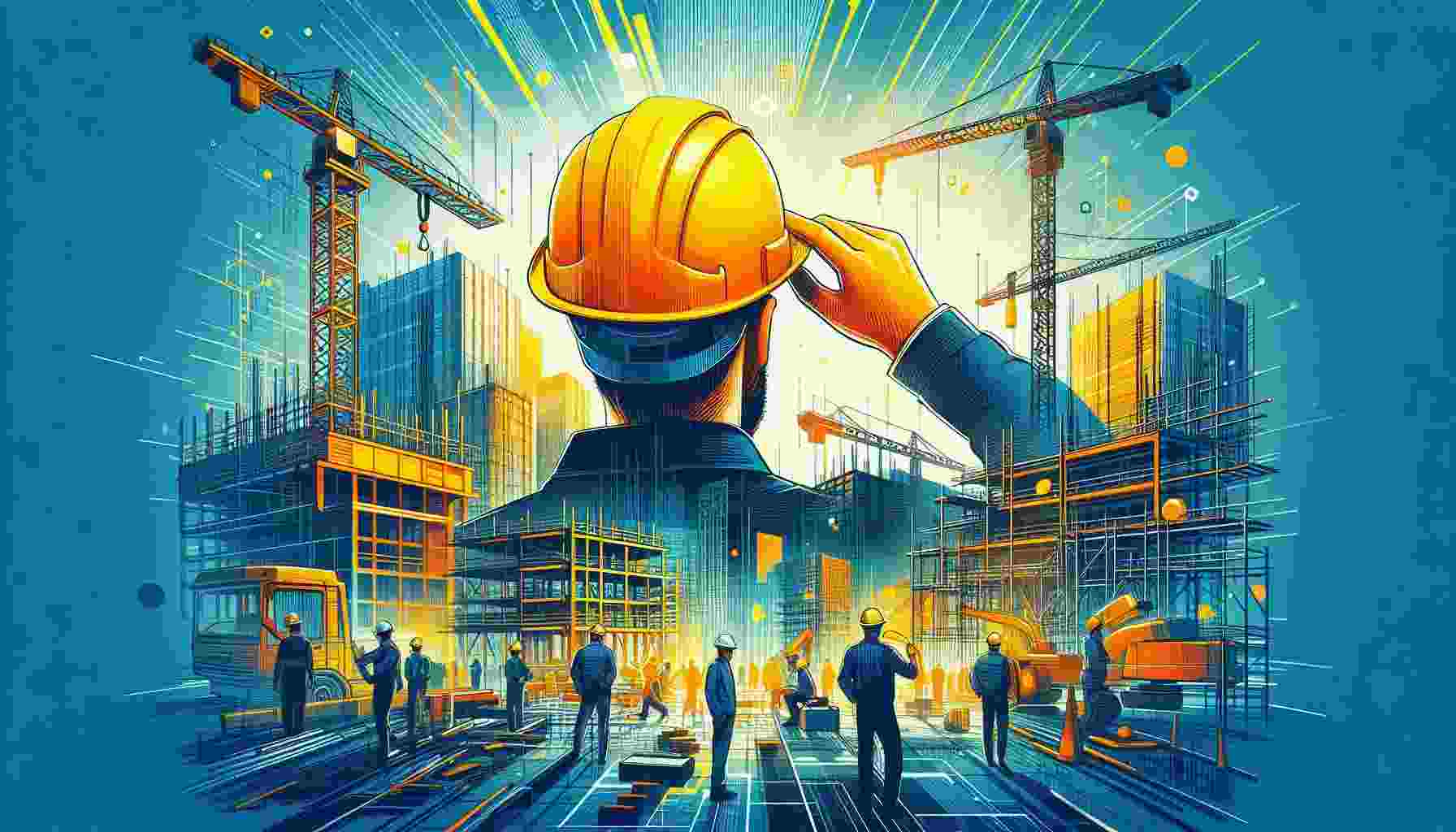According to the Occupational Safety and Health Administration (OSHA), head protection is a non-negotiable requirement on construction sites. And for good reason! These trusty helmets have been keeping noggins safe since the early 1900s, evolving from simple leather caps to the high-tech, impact-resistant marvels we see today.
Key Takeaways
- Construction hats are essential personal protective equipment (PPE) on building sites
- They protect workers from falling objects, bumps, and electrical hazards
- OSHA mandates the use of hard hats in construction and other hazardous work environments
- Modern hard hats are designed with advanced materials for improved safety and comfort
- Regular inspection and maintenance of construction hats is crucial for optimal protection

What Exactly is a Construction Hat?
A construction hat, in its simplest form, is a type of helmet used to protect a worker’s head from injury due to falling objects, impact with other objects, debris, bad weather and electric shock. But it’s so much more than just a plastic shell!
These protective headgears are typically made from high-density polyethylene (HDPE) or advanced thermoplastics. They consist of a hard outer shell and a suspension system inside that acts as a shock absorber. Some modern versions even come with additional features like built-in face shields, earmuffs, and ventilation systems.
Fun fact: Did you know that the color of a hard hat can actually mean something? While it’s not a universal standard, many construction sites use color coding to identify different roles or levels of authority. For example, white hats are often worn by supervisors or engineers, while orange ones might be used by road crews or lifting operators.

The Importance of Construction Hats on Building Sites
I remember my first day on a construction site – the noise, the dust, and the constant movement of people and machinery. It was overwhelming! But one thing stood out – everyone, and I mean EVERYONE, was wearing a hard hat. That’s when it really hit home how crucial these seemingly simple pieces of equipment are.
Construction sites are like obstacle courses of potential hazards. You’ve got tools and materials being moved around, work happening at different levels, and let’s not forget about the unpredictable nature of, well, nature! A sudden gust of wind could send a loose piece of material flying, or a moment’s distraction could lead to a painful encounter with a low-hanging beam.
Here’s why construction hats are absolutely essential:
- Protection from Falling Objects: This is the primary function of a hard hat. Whether it’s a dropped tool from a higher level or debris from ongoing work, your trusty hat is there to take the hit.
- Impact Protection: Accidentally bumping your head against scaffolding or equipment happens more often than you’d think. A good hard hat absorbs much of this impact, reducing the risk of injury.
- Electrical Safety: Many hard hats are designed to provide some level of protection against electrical hazards. This is crucial in environments where live wires or electrical equipment are present.
- Visibility: Many modern hard hats come in bright colors or with reflective strips, making workers more visible in low-light conditions or busy sites.
- Weather Protection: While not their primary purpose, hard hats do offer some protection against sun, rain, and even falling ice in colder climates.
Types of Construction Hats
Not all hard hats are created equal! There are different types designed for various working conditions and potential hazards. The two main classifications are:
Type I Hard Hats
These are designed to reduce the force of impact from blows to the top of the head. They’re the most common type you’ll see on construction sites.
Type II Hard Hats
These offer protection from both top and lateral impacts. They’re often used in more hazardous environments or where there’s a risk of side impacts.
Within these types, hard hats are further classified into three electrical classes:
- Class E (Electrical): Tested to withstand 20,000 volts
- Class G (General): Tested to withstand 2,200 volts
- Class C (Conductive): Provide no electrical protection
Choosing the right type of hard hat depends on the specific hazards present in your work environment. It’s always best to consult with safety professionals or refer to your company’s safety guidelines when selecting appropriate head protection.

How to Properly Wear and Maintain Your Construction Hat
Alright, so you’ve got your shiny new hard hat. But wearing it isn’t as simple as just plonking it on your head and heading off to work. There’s a right way to wear and care for your construction hat to ensure it provides maximum protection.
Proper Fitting
- Adjust the suspension system so the hat sits about 1-1.25 inches above your eyebrows
- The brim should be level when you’re standing straight
- The hat shouldn’t rock side to side or front to back when you shake your head
- Never wear your hard hat backwards (unless it’s specifically designed for reverse wear)
Maintenance Tips
- Clean your hard hat regularly with mild soap and warm water
- Inspect it daily for cracks, dents, or any signs of damage
- Replace the suspension system every 12 months
- Replace the entire hard hat every 5 years, or sooner if it’s been involved in an impact
- Don’t store your hard hat in direct sunlight or extreme temperatures
Remember, your hard hat is only effective if it’s in good condition and worn correctly. Treat it like the lifesaving piece of equipment it is!
Now that we’ve covered the basics of construction hats, their importance, types, and proper use, let’s dive into some of the latest innovations in hard hat technology and how they’re making construction sites even safer…
Latest Innovations in Hard Hat Technology
Hard hats have come a long way since their early days! These days, we’re seeing some pretty cool advancements that are making construction sites safer and more comfortable for workers. Let me tell you about some of the coolest new features I’ve seen:
Smart Hard Hats
Imagine a hard hat that can detect if you’ve fallen or been exposed to harmful gases. That’s exactly what some of these new smart hard hats can do! They’re equipped with sensors that can alert supervisors if a worker is in danger. Some even have GPS tracking for added safety in remote locations.
Improved Ventilation Systems
Working under the hot sun all day can be brutal. That’s why I’m loving these new hard hats with advanced ventilation systems. They keep your head cool and reduce sweat, which means you’re more comfortable and less likely to take off your hat when you shouldn’t.
Integrated Communication Systems
Ever tried to use a walkie-talkie while wearing a hard hat? It’s not fun. But now, some hard hats come with built-in communication systems. You can talk to your team without fumbling with extra equipment. It’s like something out of a sci-fi movie!
Lightweight Materials
New materials are making hard hats lighter than ever without compromising on safety. I recently tried one that felt like it was barely there, but it still met all the safety standards. Your neck will thank you after a long day on site!
The Future of Construction Head Protection
So, what’s next for construction hats? Based on current trends, I think we’re going to see some pretty exciting developments:
- Augmented Reality (AR) Integration: Imagine a hard hat with a heads-up display showing you important information or instructions right before your eyes.
- Biodegradable Materials: As sustainability becomes more important, we might see hard hats made from eco-friendly materials that don’t compromise on safety.
- Customized Fit Technology: 3D scanning could lead to hard hats that are perfectly fitted to each individual worker’s head shape.
- Enhanced Impact Absorption: New materials and designs could provide even better protection against impacts from all angles.
The future of construction head protection is looking bright (and safe)! But remember, even the most advanced hard hat won’t protect you if you don’t wear it properly.
The Role of Regulations in Construction Hat Use
Now, I know talking about regulations might not be the most exciting topic, but it’s super important when it comes to construction hats. OSHA (Occupational Safety and Health Administration) has some pretty strict rules about head protection on construction sites.
Here’s the deal: If there’s any chance of head injury from falling objects, fixed objects, or electrical shock, hard hats are mandatory. No ifs, ands, or buts about it. And it’s not just about having a hard hat – it needs to be the right type for the job and in good condition.
Employers are responsible for providing appropriate hard hats and ensuring they’re being used correctly. As a worker, you’ve got the right to a safe workplace, and that includes proper head protection. Don’t be afraid to speak up if you’re not given the right equipment!
Construction hats aren’t just a good idea – they’re the law. And trust me, those regulations have saved countless lives over the years.
So there you have it – the lowdown on construction hats. From their humble beginnings to high-tech future, these unassuming pieces of equipment play a crucial role in keeping workers safe. Next time you pass a construction site, take a moment to appreciate those hard-working hats!
Remember, whether you’re a seasoned pro or just starting out in construction, your hard hat is your best friend on site. Treat it well, wear it right, and it’ll have your back (or should I say, your head) when you need it most. Stay safe out there, folks!
Frequently Asked Questions
1. How often should I replace my construction hat?
You should replace your construction hat at least every 5 years, even if it appears to be in good condition. However, if your hard hat has been involved in an impact, shows signs of damage, or has been exposed to extreme heat or chemicals, replace it immediately. The suspension system should be replaced annually.
2. Can I wear a baseball cap under my hard hat?
It’s generally not recommended to wear anything under your hard hat, including baseball caps. This can interfere with the hat’s suspension system and reduce its protective capabilities. If you need sun protection, look for hard hats with built-in brims or attachable sun shields designed for use with hard hats.
3. Are there specific hard hats for women?
While most hard hats are designed to be unisex, some manufacturers do produce models specifically designed for women. These typically have a slightly different shape to accommodate longer hair and may come in smaller sizes. However, the most important factor is fit – regardless of gender, your hard hat should fit snugly and comfortably.
4. Can I paint or put stickers on my hard hat?
It’s generally not recommended to paint or put stickers on your hard hat as this can hide cracks or other damage. Some adhesives in stickers can also degrade the hard hat material over time. If you need to mark your hard hat for identification, use water-based paint and keep it to a minimum.
5. What’s the difference between a bump cap and a hard hat?
Bump caps are designed to protect against minor bumps and scrapes, typically in environments where there’s no risk of falling objects. Hard hats, on the other hand, provide much more substantial protection against falling objects and other serious impacts. In most construction settings, a proper hard hat is required – bump caps are not sufficient.
6. How should I store my construction hat when not in use?
Store your hard hat in a cool, dry place out of direct sunlight. Extreme heat or cold can degrade the plastic over time. Don’t store heavy items on top of your hard hat, as this can deform its shape. Some workers like to use hard hat racks or bags designed specifically for storing and transporting hard hats.
7. Can I wear my hard hat backwards?
Most hard hats are designed to be worn with the brim facing forward. However, some models are designed for reverse donning, allowing them to be worn backwards. Check your hard hat’s specifications – if it’s not explicitly approved for reverse wear, always wear it with the brim facing forward.
8. Are there hard hats for cold weather?
Yes, there are hard hats designed for cold weather use. These often have features like insulation, ear covers, or attachments for winter liners. Some workers use hard hat beanies or liners, but make sure these are specifically designed for use with hard hats and don’t interfere with the hat’s protective capabilities.
9. How tight should my hard hat be?
Your hard hat should be snug but not uncomfortably tight. You should be able to turn your head without the hat moving independently. If you bend over, the hat shouldn’t fall off. However, if it’s leaving marks on your forehead or giving you a headache, it’s too tight. Most hard hats have adjustable suspension systems to help you find the right fit.
10. Can I use a regular bicycle helmet instead of a hard hat on a construction site?
No, bicycle helmets and other sports helmets are not suitable substitutes for hard hats on construction sites. They’re designed for different types of impacts and don’t provide the same level of protection against falling objects or electrical hazards. Always use a proper, OSHA-approved hard hat on construction sites.






